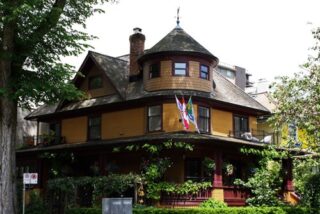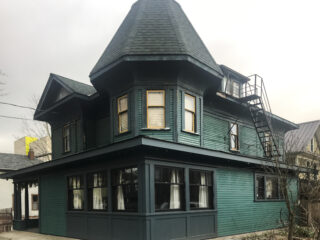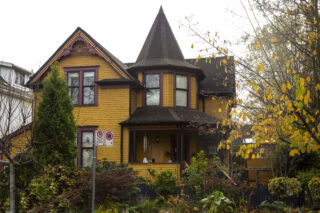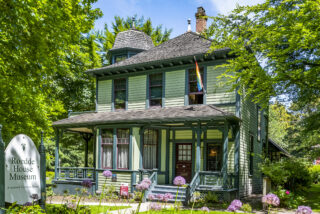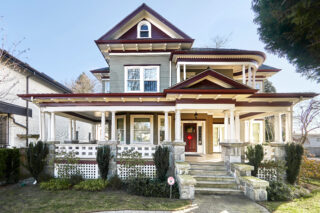A variety of cladding types on Queen Anne Revival houses provide contrasting textures. This can include narrow siding, drop siding, patterned shingles, and drop-siding within a frame. The façade is often decorated with moldings highlighting floors, while ornamentation such as gingerbread, ornamental spindles, and brackets enliven porches and gables. Windows are usually double-hung, and may have leaded or stained glass in upper sections.
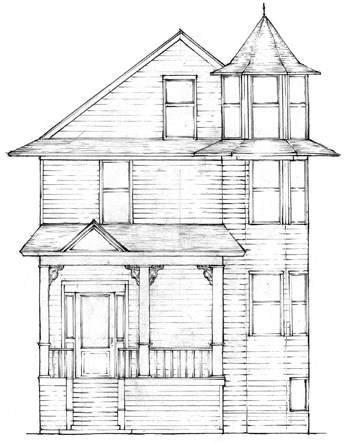
Click on the diagram or expand the term index to learn more about the features.
Balustrade
An entire railing system, as along the edge of a balcony, including a top rail, bottom rail, and balusters.
Cladding
Also referred to as siding, cladding is the outermost layer of the wall system, providing resistance to the natural elements and acting as a control device for drainage. Depending on the house style, various kinds of stucco, horizontal and vertical boards may be used as cladding. Types of cladding/siding: Board and Batten Clapboard Drop Lap Masonry Shakes Shingle Shiplap Stucco
Column
A supporting post, generally round. In classical orders, the column consists of a base, shaft, and capital.
Double Hung Window
A pair of superimposed wooden sashes that are offset so as to slide up and down within the same frame. A double hung window that has horns on its upper sash are most likely pre World War I.
Front Stairs
Bridging the porch and street, the front stairs provide easy access to the home through the use of treads and risers. Staircases are found in a number of configurations on the façade in response to accessibility and style.
Porch
A covered platform, usually with its own roof, attached to a building, serving as a covered entryway. May be limited to covering the front door area or may extend along the full length of the façade.
Turret
A circular or polygonal projecting bay or structure, usually with a steep pointed roof.
Form
These now-uncommon houses have asymmetrical multi-storey profiles with a turret – that is, a projecting bay, often hexagonal or octagonal, extending from the house walls and topped with a pointed roof that might be hipped or conical. The house’s main roof may be gabled or hipped. Many are clad in a variety of textures, including fishscale shingles and narrow board siding. Porches may have a pediment in line with the front door and posts with elaborate fretwork brackets (“gingerbread”). Remaining Queen Anne style houses are local landmarks, especially in Grandview.
Details
- Steep, irregular roof
- Corner tower or turret, sometimes with conical roof
- Asymmetrical shape
- Partial or full width porch – often wrap around
- Bay windows
- Gingerbread (elaborate fretwork braces)
- A variety of surface textures (ie. fishscale shingles)
Materials
Background
The Queen Anne Revival style has little to do with the actual English Queen Anne or architecture from her reign (1702 – 14). One of the most popular styles of the late Victorian era, the Queen Anne Revival style developed in Britain thanks to a renewed interest in architecture of the late medieval period. Following its introduction to North America, it quickly adapted for the new environment. Rather than symmetrical masonry buildings in the English style, the Vancouver Queen Anne Revival is a confection of textures and gingerbread ornamentation. The term is used specifically to describe turreted pre-World War One houses.
Pattern books and the first architectural magazine, The American Architect and Building News, made the Queen Anne Revival popular. In Vancouver, an abundance of locally manufactured pre-cut detailing . Middle- and Upper-class homes in Vancouver, as in much of North America, made use of gingerbread detailing. The elaborate detailing, textures, and turrets of the Queen Anne style are among the most iconic of the Victorian-era styles.

